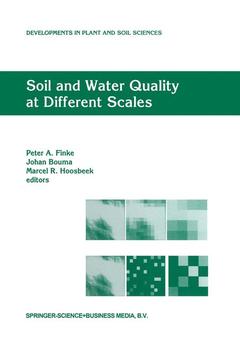Soil and Water Quality at Different Scales, Softcover reprint of the original 1st ed. 1998 Proceedings of the Workshop “Soil and Water Quality at Different Scales” held 7–9 August 1996, Wageningen, The Netherlands Developments in Plant and Soil Sciences Series, Vol. 80
Langue : Anglais
Coordonnateurs : Finke Peter A., Bouma Johan, Hoosbeek Marcel R.

Integrated studies on the assessment and improvement of soil and water quality have to deal almost inevitably with issues of scale, since the spatial support of measurements, the model calculations and the presentation of results usually vary. This book contains the selected and edited proceedings of a workshop devoted to issues of scale entitled: `Soil and Water Quality at Different Scales', which was held in 1996 in Wageningen. It is intended for environmental researchers, scientists and MSc and PhD students.
Part 1 covers current issues and methodologies with scale related soil and water quality research. Part 2 covers agroecological and hydrological case studies in which scale transforms form an important part of the research chain. Part 3 consists of papers focusing on methodologies and up and downscaling. Part 4 contains review papers based on modellers' and statisticians' considerations as well as the papers and posters presented during the workshop. Part 5 consists of short research notes.
Part 1 covers current issues and methodologies with scale related soil and water quality research. Part 2 covers agroecological and hydrological case studies in which scale transforms form an important part of the research chain. Part 3 consists of papers focusing on methodologies and up and downscaling. Part 4 contains review papers based on modellers' and statisticians' considerations as well as the papers and posters presented during the workshop. Part 5 consists of short research notes.
I: Keynotes.- 1. Soil and water quality at different scales: concepts, challenges, conclusions and recommendations.- 2. Relevance of scale dependent approaches for integrating biophysical and socio-economic information and development of agroecological indicators.- 3. Scale issues in agroecological research chains.- 4. Obtaining soil and land quality indicators using research chains and geostatistical methods.- 5. Some considerations on methods for spatially aggregating and disaggregating soil information.- II: Agroecological and Hydrological Case Studies.- 6. Small scale variability in the flow of water and solutes, and implications for lysimeter studies of solute leaching.- 7. Solute transport at the pedon and polypedon scales.- 8. Space-time upscaling of plot-based research information: frost tillage.- 9. Mapping and interpreting soil textural layers to assess agri-chemical movement at several scales along the eastern seaboard (USA).- 10. Status and trends of soil salinity at different scales: the case for the irrigated cotton growing region of eastern Australia.- 11. Investigating soil and groundwater quality at different scales in a forested catchment: the Waldstein case study.- 12. Slope deposits and water paths in a spring catchment, Frankenwald, Bavaria, Germany.- 13. Hydromorphic soils, hydrology and water quality: spatial distribution and functional modelling at different scales.- 14. Upscaling a simple erosion model from small areas to a large region.- 15. Research on soil fertility decline in tropical environments: integration of spatial scales.- 16. Soil absorbing complex properties of Russian boreal soils and its dependence on the spatial scale of study area.- 17. The influence of nitrate reduction strategies on the temporal development of the nitrate pollution of soil and groundwater throughout Germany: a regionally differentiated case study.- 18. Food supply capacity study at global scale.- III: Methods for Scale Transfer.- 19. Upscaling hydraulic conductivity: theory and examples from geohydrological studies.- 20. Modelling cadmium accumulation at a regional scale in the Netherlands.- 21. The use of upscaling procedures in the application of soil acidification models at different spatial scales.- IV: Review Papers.- 22. Modelling concepts and their relation to the scale of the problem.- 23. Prediction error through modelling concepts and uncertainty from basic data.- 24. Uncertainty analysis in environmental modelling under a change of spatial scale.- V: Extended Poster Abstracts — Short Communications.- 25. Regression model to predict travel time for chloride leaching through pedons using soil morphological characteristics.- 26. Evaluation of nitrate leaching risk at site and farm level.- 27. Information on within-field variability from sequences of yield maps: multivariate classification as a first step of interpretation.- 28. Influence of the cultivation system and the relief on the water content of the Ap Horizon of land subject to different use.- 29. Nutrient losses in surface and subsurface flow from pasture applied poultry litter and composted poultry litter.- 30. Distribution of inorganic nitrogen in agricultural soils at different dates and scales.- 31. The development of a hydrological classification of UK soils and the inherent scale changes.- 32. Regional mass flux balancing for controlling gentle soil remediation operations.- 33. Using a GIS system in mapping risks of nitrate leaching and erosion on the basis of SOIL/ SOIL-N and USLE simulations.- 34. Modelling water and nitrogen dynamics at threedifferent spatial scales — influence of different data aggregation levels on simulation results.- 35. Leaching of nitrogen and phosphorus from rural areas to surface waters in the Netherlands.
Preface. Part I: Keynotes. 1. Soil and water quality at different scales: concepts, challenges, conclusions and recommendations, J. Bouma, et al. 2. Relevance of scale dependent approaches for integrating biophysical and socio-economic information and development of agroecological indicators, J. Dumanski, et al. 3. Scale issues in agroecological research chains, R.J. Wagenet. 4. Obtaining soil and land quality indicators using research chains and geostatistical methods, M.R. Hoosbeek, J. Bouma. 5. Some considerations on methods for spatially aggregating and disaggregating soil information, A.B. McBratney. Part II : Agroecological and Hydrological Case Studies. 6. Small scale variability in the flow of water and solutes, and implications for lysimeter studies of solute leaching, L.P. Simmon
Date de parution : 04-2011
Ouvrage de 328 p.
17.8x25.4 cm
Mots-clés :
Soil fertility; Tillage; erosion; groundwater; hydrology; pollution; soil; hydrogeology; air pollution and air quality
© 2024 LAVOISIER S.A.S.



